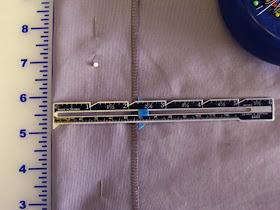Tuesday, June 28, 2011
Crown Royal Quilt Fit For A King
This is a quilt that I made for a friend. It is only the second quilt that I have made. It took me about a year and a half to complete. Just yesterday I found out that it was saved from a horrible RV fire.
For the quilt top, I started with two king sized sheets and well over 100 crown royal bags. I pre washed everything just to be sure. It was a good thing because all that flannel turned my washer purple! Then I cut all the backs and draw chords off the bags. Thankfully the sheets have a plaid pattern printed on them. I used the plaid to line up the bags nice and straight. As I stitched the bags down I left their tops open so that I could put a few handfuls of poly stuffing in each one. Then I just topstitched the bags shut.
At this point with the top done I made the quilt sandwich. I put the second king sized sheet on the floor face down. Then I spread out the thinnest polyester batting that I could find. Next I spread out the quilt top face up. Starting in the center I used safety pins to hold everything together.
Now it wast time to quilt all the layers together. At the top of each bag I used yellow yarn to create a bow like the original bag had. I would have used the original ties but they were too thick to sew through the quilt. After each bag had it's own little bow I stitched the edges of the quilt together and trimmed off all the extra fabric and batting leaving 1" all the way around. To finish the quilt I used 1" wide prepackaged cotton blanket binding in a golden yellow color.
Monday, March 7, 2011
How To Create A Pattern For A New Pair Of Jeans From An Old Pair
 For this project I used an old pair of jeans. The jeans fit me perfectly but they were full of holes and I was going to throw them away. They were perfect for cutting apart to draft a new pattern. Below are the steps I used.
For this project I used an old pair of jeans. The jeans fit me perfectly but they were full of holes and I was going to throw them away. They were perfect for cutting apart to draft a new pattern. Below are the steps I used.1. First I cut jeans apart along the seams. I only cut one side of the jeans apart because both sides are almost the same.
 2. Then I laid the pieces out as flat as I could on pattern paper. The paper I use for this is just leftovers from a large commercial printer. I can't believe they were just going to throw all that good paper away. Large pieces of newsprint paper also work well for this but you might have to tape a few pieces together. Pattern tracing paper, with the 1" blue grid printed on it, also works really well but it costs more than the other two options.
2. Then I laid the pieces out as flat as I could on pattern paper. The paper I use for this is just leftovers from a large commercial printer. I can't believe they were just going to throw all that good paper away. Large pieces of newsprint paper also work well for this but you might have to tape a few pieces together. Pattern tracing paper, with the 1" blue grid printed on it, also works really well but it costs more than the other two options.3. Next I carefully traced around all the pieces with a pencil. I think I wound up with about eleven different pieces. After each piece had been traced I set the jean parts aside.
4. I added labels to each piece so that I would be able to tell what they are and how many to cut. I also added grain lines.
5. Each piece that I traced needed to be cleaned up so I used my 3"x18" ruler and french curves to make sure that my lines were strait and smooth. I also checked to make sure that all my pieces would match up when they are sewn together.
6. Then it was time to add seam allowances. I used a 1/2" seam allowance because it is just easier than using the traditional 5/8". For all the straight lines I used my 3"x18" ruler again. For all the curved lines a compass works wonders. Just open the compass up to your desired seam allowance and then trace around any curve.
7. The last step to drafting the pattern was adding markings for things like pockets.
The back pockets you see on my jeans are actually from another pair and not the originals. That's one of the cool things about drafting your own pattern. You can add or change any details you want. If you are at all unsure about your drafting skills be sure to make a muslin first so that you can work out all the "kinks" first. Otherwise, just jump right in and start making your new jeans.
Wednesday, February 23, 2011
Hem Pants With A Cuff
Mark the desired length of the pants.
Add 3 1/2" to allow for the cuff and the hem.
Cut off the extra fabric.
Finish the raw edge with a serger.
Turn under 2 1/4" and pin in place.
Blind stitch the serged edge in place by machine or by hand.
Turn up 1 1/4" to form the cuff.
Secure the cuffs to the pants by stitching on the outside directly in the seams.
Press and you're done!










